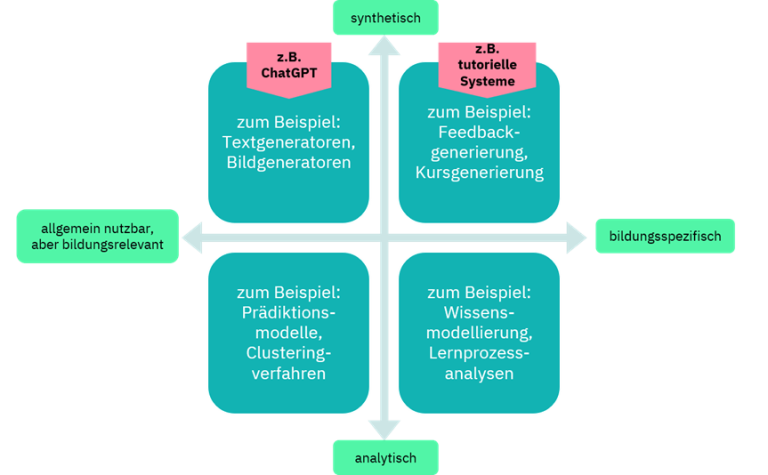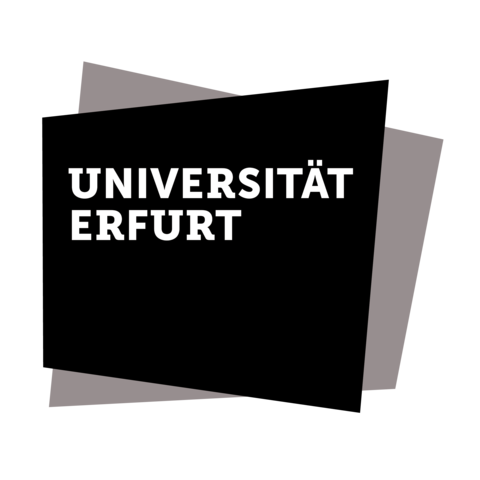AI tools and their impact on universities
Since the publication of ChatGPT by OpenAI at the end of November 2022 at the latest, almost all areas of daily life - and therefore the entire education sector in particular - have been confronted with an unprecedented number of questions, challenges and opportunities in terms of both breadth and depth. It is not without reason that cross-references such as a certain "steam engine moment" are used in this context.
Alongside the challenge of defining the possible breadth and depth of the impact of AI tools on the respective field (in our case the education sector, and more specifically the field of higher education), AI tools are an extremely dynamic, almost unmanageable field.
It is extremely important to understand that ChatGPT is a very present, but only one A section of a rapidly growing field. The field of AI tools is currently growing strongly and steadily with several dozen new tools of various types and quality being launched every day (the portal theresanaiforthat.com lists 7,502 tools for 2,062 different use cases, as at 31.08.2023). In addition - also as at 31.08.2023 - for ChatGPT more than 640 plugins with various functional enhancements. Trend: strong growth.
Core objectives in relation to university teaching when considering AI tools
- First, develop a basic understanding that it is absolutely necessary to narrow down or focus in order not to get lost in the field of tools (suggestions below).
- Getting to know the available ranges (positions, handling/utilization possibilities), their interpretation and use for teaching.
- Gain confidence in dealing with AI tools at an individual level and generally become or remain capable of acting with regard to AI tools and the associated challenges.
Challenges and opportunities of AI tools for university teaching
Challenges | Opportunities |
AI tools are currently used in teaching on a voluntary basis - for all parties - as the data protection situation is often unclear (this means, for example, that non-use must not lead to any disadvantages or that no confidential or personal information is to be used when entering prompts).
| A change in awareness is already clearly recognizable as a result of the multi-layered discourse: there are definitely new opportunities for professional debate/examination of content/also increased efficiency.
|
The licensing situation is often unclear with various options: Provision of university-owned accounts (if legally sound?), integrating students via data protection-compliant platforms (always available?) - currently, however, there is rather "uncontrolled growth" with all the associated challenges.
| At the same time, there are opportunities through new, necessary support for students' digital skills (rapidly growing importance and to be secured by HS).
|
One challenge is the limited availability of best practice examples that universities can use as a guide. Decisions/provisions must be constantly scrutinized and, if necessary, adapted to current developments. | Ultimately, there are always opportunities for universities to develop further by dealing with challenges and confronting new issues (so the need for change and renewal processes are ultimately not a completely new situation - what is probably new is the speed at which everything is happening). |
Possibilities for the classification of AI tools
a) Theoretical classification according to the approach of the tool (synthesis vs. analysis) and according to the focus of the purpose of use (general use vs. specific use):

b) Practically oriented classification/grouping according to possible applications in teaching:
Text-generating AI tools:
- General text assistance/text tools: e.g. ChatGPT, perplexity.ai
- Special text tools: e.g. text-cortex, Writesonic, scite.ai
- Special case foreign languages/translations: e.g. DeepL, DeepL Write
Visualizing AI tools:
- Presentations/graphics: e.g. beautiful.ai, kroma.ai, Canva, Simplified, Slides.AI
- Image-generating tools: e.g. Crayon (DALL-E basis), Stable Diffusion, Neural.Love, Midjourney
- Video generating tools: e.g. designs.ai, NVIDIA AI (available in the future and significant qualitative leap)
"Special cases":
- 3D-generating tools: e.g. 3Dpresso, OpenAI Point-E
- Special case research documents/research data: e.g. scite.ai, elicit
- Further use cases in the academic sector can be found, for example, in the overview AI tools for Academia
Application scenarios for AI tools in university teaching
When considering the effects of AI tools on university teaching, the following four areas in particular come into focus (the effects of AI tools and possible scope for design are summarized below):
1) General legal aspects (framework conditions)
Note: Since the use of AI and AI tools is currently handled and interpreted differently at each university and no legally binding guidance is available, no binding recommendations can (yet) be made at this point.
Larger universities in particular have issued recommendations within their sphere of influence (see, for example, various dossiers from the Hochschulforum Digitalisierung). Individual legal opinions (e.g. Ruhr University Bochum) and guidelines from higher-level bodies such as the aforementioned Hochschulforum Digitalisierung, the Centrum für Hochschulentwicklung or the Deutsche Gesellschaft für Hochschuldidaktik are also available. However, there is currently no uniformity or even binding nature (yet).
The core fields concerned and their interpretations range between the following positions:
- Authorship of generated content (positions vary between: ChatGPT vs. respective user)
- Dealing with references (positions vary between: "already covered by existing regulations" vs. "blind spot in existing regulations")
- Affected by declarations of independence (opinions vary between: "already covered by existing regulations" vs. "blind spot in existing regulations")
2) Affectedness of audit scenarios/questions
Note: The (legal) framework is provided by the applicable examination regulations, declarations of independence or guidelines of the respective university.
Various positions can also be found in this field: One fundamentally possible approach (and one that can currently be found) is to respond to AI tools with a return to conventional, supposedly less vulnerable forms of examination ("renaissance of the oral and the written exam in the classic sense"). On the other hand, the opposite approach can be found, which advocates an increase in the reflective component or, if necessary, the first-time addition of a reflective component in examinations and concentrates more on the adaptation of tasks: e.g. consciously exploring the limits of AI, reduction of pure fact reproduction.
Concrete effects on examination performance/performance records:
- There is currently no need for action for face-to-face examinations, digital face-to-face examinations (if the use of technically controlled environments is permitted) and oral examinations, but written work done at home (including preparations for papers/presentations) and situations in which there would be sufficient time to use AI are critical.
- A general ban on the use of AI tools does not make sense, as there are currently no ways of reliably recognizing AI-generated texts. AI-generated texts are not plagiarized and therefore cannot be detected by plagiarism software.
- Currently offered solutions for recognizing AI-generated texts provide both false positive and false negative results and are therefore not suitable for effectively monitoring a ban.
Recommendations if no changes to the examination format itself are possible:
- Formulate topics or tasks for written assignments that are as concrete/specific as possible (even) more critical look at the list of sources/careful comparison with content; careful reading of the submitted work
- Enable co-authorship between students and AI tool (this may require adaptation of the declarations of independence)
Recommendations if changes to examination formats can be implemented:
- Completion of short technical discussions during or after submission of a paper
- Submission of interim results of the work / consideration of the reflected development process in the assessment (possibly redefining the meaning of portfolio work)
3) Design of teaching or concrete use in teaching
Note: The (legal) framework is provided by the applicable examination regulations, declarations of independence or guidelines of the respective university.
Opportunities - targeted integration of AI in teaching:
- Establish rules for the use of AI for this purpose (range here too: from a general ban to unregulated use, but there are also middle ways: defined)
- Integration of AI/AI tools as a topic or subject of courses (objective: examination of...): e.g. as targeted testing of AI, exploration of borderline areas in the respective discipline, examination and, in particular, discussion
- Dealing with the technical topic at a higher level by understanding the basic functioning of AI tools / finding out the limitations of text-generating AI and critically reflecting on the AI-generated output
4) Use as teaching support or work aid
AI tools also offer teachers a wide range of support and can serve as an aid for teaching and research as well as for numerous administrative tasks.
Practical application examples - relief/support, especially for administrative/routine tasks:
- General use for the creation of (text/image) content: e.g. text templates of all kinds, illustrations/graphics for presentations, creation of tables (also from own data), creation of program code etc., creation/rewording of learning materials in simpler language, translations of existing content etc. (the use from the teacher's point of view is therefore not fundamentally different from the possible use by students).
- Help with or suggestions for the design of learning units: Suggestions for introductory questions, specific cases or problems, creation of advanced organizers (overview of content, learning objectives), suggestions for tasks, worksheets, quizzes, etc.
- Implementation of constructive alignment/help with semester planning: formulate learning objectives (also related to learning objective levels), suggestions for semester planning (with input of the relevant framework conditions), create/revise module descriptions/event descriptions, etc.
- Suggestions for examination scenarios: Suggested wording for examination forms or tasks (e.g. single/multiple choice tasks) as well as for associated assessments (suggestions for sample solutions and suggestions for assessment criteria), suggestions for feedback texts/review texts - note: the actual assessment must be carried out by humans at present!
- Support for all forms of (written) communication: use of suggestions for invitation texts, templates for announcements, news, etc.

